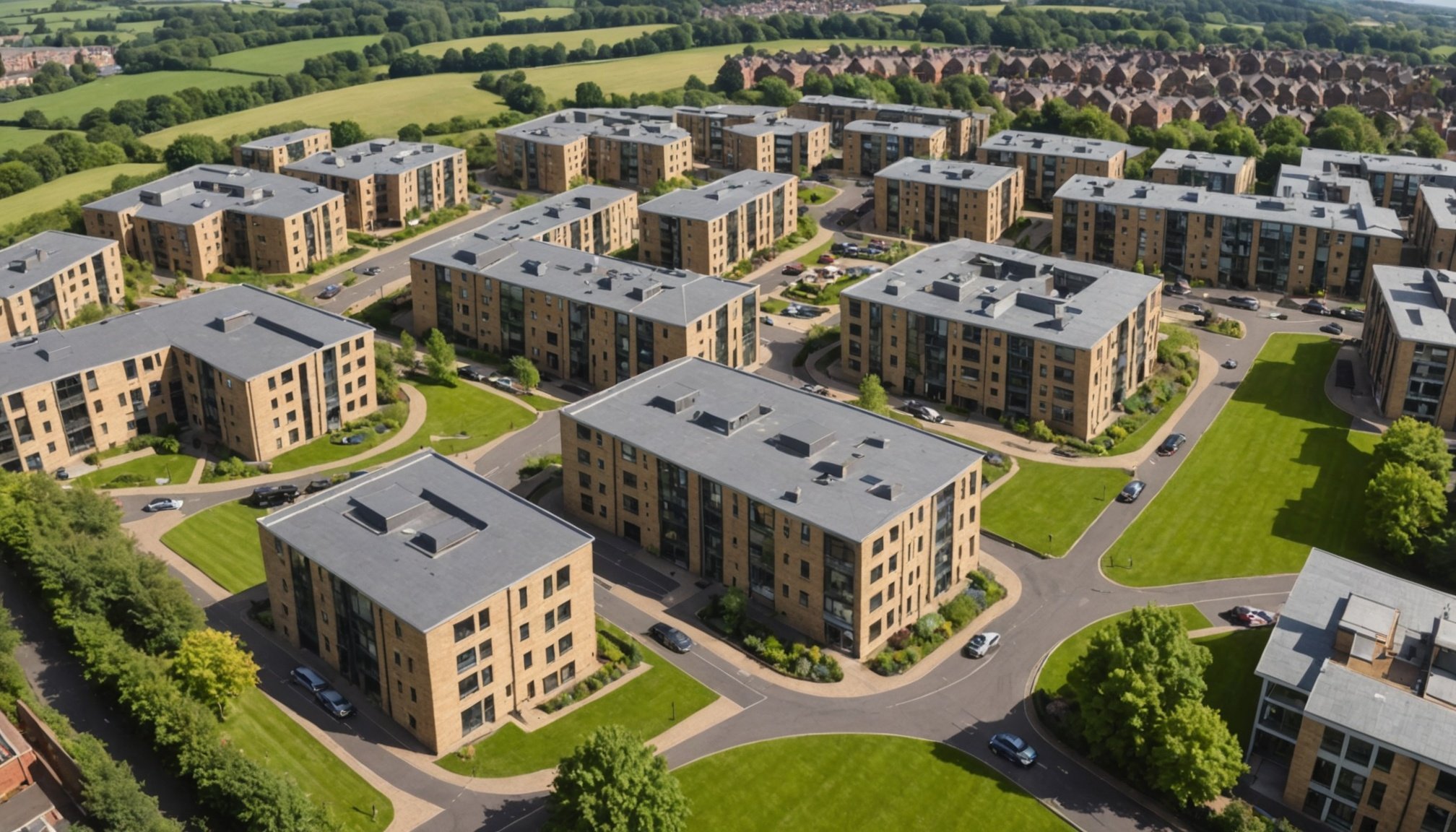Revamping Sheffield’s New Housing Developments: Harnessing Smart City Innovations for Sustainable Property Growth
Sheffield, a city known for its rich history and vibrant culture, is undergoing a significant transformation in its housing sector. With a focus on sustainability, innovation, and community engagement, Sheffield is setting a new standard for urban development. Here’s a deep dive into how smart city innovations are revolutionizing the city’s new housing developments.
The Current State of Sheffield’s Housing Market
Sheffield’s housing market has been on a steady growth trajectory, driven by several key factors. As of 2024, the average house price in Sheffield stands at £224,000, with a modest 1.6% year-on-year increase. This stability makes Sheffield an attractive and affordable option for buyers compared to other major cities in the UK[1].
This might interest you : Maximizing community impact: essential strategies for property developers in emerging uk housing projects
The rental market is also thriving, with average monthly rents rising to £863, an 8.9% increase from the previous year. This demand is fueled by a diverse demographic, including students, young professionals, and families. However, despite this growth, the market faces challenges such as supply shortages and mortgage affordability.
Key Drivers of Growth and Innovation
Several factors are driving the growth and innovation in Sheffield’s housing market.
Also read : Effective Tactics for Reducing Property Vacancy Rates Across the UK: A Comprehensive Guide
Economic Growth
Sheffield is the UK’s second-fastest-growing city economy, after Manchester. The city’s diverse economy, which includes advanced manufacturing, technology, and education, continues to attract businesses and professionals. This economic vitality fuels housing demand and supports steady price growth[1].
Population Growth
Sheffield’s population has steadily increased, reaching approximately 590,000 in 2024. The city’s young and dynamic demographic, including students and professionals staying in the city post-graduation, contributes to the rising demand for housing[1].
Regeneration Projects
Major projects like the Heart of the City II development and the expansion of Kelham Island are transforming Sheffield’s landscape. These initiatives enhance the city’s appeal and drive up property values in key areas. For instance, the Heart of the City II project is a significant urban regeneration effort that includes new public spaces, offices, and residential units, making the city more vibrant and attractive[1].
Integrating Smart City Technologies
Smart city innovations are at the forefront of Sheffield’s new housing developments. Here’s how these technologies are being integrated:
Smart Home Technologies
New housing developments in Sheffield are increasingly incorporating smart home technologies to optimize energy usage, enhance security, and improve communication among residents. For example, smart thermostats and energy-efficient appliances are becoming standard features, helping residents reduce their energy consumption and lower their utility bills[4].
Green Spaces and Urban Planning
The integration of green spaces is crucial for sustainable growth. Successful projects in Sheffield highlight the importance of accessibility and ecological benefits in green space design. For instance, the Grey to Green project, which transforms grey infrastructure into green spaces, has enhanced social connections and improved mental well-being among residents[3].
Benefits of Smart City Innovations
The incorporation of smart city technologies and green spaces offers numerous benefits.
Enhanced Mental Health and Community Cohesion
Studies have shown that individuals residing near natural environments experience reduced stress levels and improved overall well-being. Green spaces serve as social hubs, encouraging interaction among community members and strengthening social ties[3].
Economic Impacts
Properties located near green spaces often see increased values, attracting potential buyers and investors. This can lead to higher property taxes, benefiting community resources and services, and fostering a cycle of economic growth.
Data-Driven Decision Making
The use of Geographic Information Systems (GIS) and remote sensing provides detailed environmental data, helping planners identify optimal locations for green spaces. Collaboration platforms enable stakeholders to visualize and modify plans in real-time, streamlining decision-making processes[3].
Case Studies: Successful Integration of Smart City Technologies
Here are a few case studies that illustrate the successful integration of smart city technologies in Sheffield’s new housing developments:
Case Study: Kelham Island
Kelham Island is a prime example of how smart city technologies can transform a neighborhood. The area has seen significant investment in smart home technologies, including energy-efficient homes and advanced security systems. Additionally, the integration of green spaces has enhanced community engagement and mental well-being among residents.
| Feature | Description |
|---|---|
| Smart Home Technologies | Energy-efficient appliances, smart thermostats, advanced security systems |
| Green Spaces | Public parks, community gardens, accessible walkways |
| Community Engagement | Regular community events, workshops, and feedback sessions |
| Economic Impact | Increased property values, higher property taxes, local economic stimulation |
Case Study: Heart of the City II
The Heart of the City II development is a major urban regeneration project that includes new public spaces, offices, and residential units. The project incorporates smart city technologies such as smart streetlights and data-driven urban planning. This has not only enhanced the city’s appeal but also improved the quality of life for residents.
| Feature | Description |
|---|---|
| Smart Streetlights | Energy-efficient LED lights, real-time monitoring and maintenance |
| Data-Driven Planning | Use of GIS and remote sensing for optimal urban planning |
| Public Spaces | New public parks, community areas, and walkways |
| Economic Impact | Increased investment, job creation, and local economic growth |
Challenges and Solutions
While integrating smart city technologies and green spaces offers numerous benefits, there are also several challenges to overcome.
Development Challenges
Common obstacles include limited space, competing land uses, and environmental concerns. Regulatory policy barriers can also hinder the integration of green spaces into urban landscapes.
Funding Solutions
Securing the necessary funds is a significant hurdle. Innovative funding solutions such as public-private partnerships, grants dedicated to urban renewal, and creative avenues like crowdfunding and green bonds can ensure projects do not stall due to lack of resources[3].
Strategies for Success
To maximize the benefits of smart city innovations in housing developments, several strategies can be employed:
Stakeholder Engagement
Involving local residents and businesses from the outset is crucial. Community feedback can reveal specific needs and preferences, enhancing the relevance and use of green spaces. Regular meetings and workshops can foster open dialogue and gain valuable insights[3].
Public-Private Partnerships
Collaboration between the public and private sectors can provide the necessary resources and expertise. For example, the University of Sheffield’s “Made Together” programme involves partnerships with local authorities, businesses, and community organizations to enhance the region’s health, greenness, vibrancy, and innovation[2].
Long-Term Investment
Investing in smart city technologies and green spaces is a long-term strategy. It requires a commitment to sustainability and a vision for the future. As Sheffield City Council and local businesses continue to invest in these initiatives, the city is likely to see sustained growth and improved quality of life for its residents.
Practical Insights and Actionable Advice
For those looking to invest in or develop housing in Sheffield, here are some practical insights and actionable advice:
- Timing the Market: Understanding the current market trends and timing your investment wisely can help you maximize returns. With projected house price growth of 3-4% in 2025, now is a good time to invest[1].
- Focus on High-Demand Areas: Areas like Kelham Island, Sharrow, and Hillsborough offer strong rental yields and potential for capital appreciation. These areas are also seeing significant investment in smart city technologies and green spaces[1].
- Balancing Your Portfolio: Diversifying your investment portfolio to include a mix of rental properties and owner-occupied homes can help you navigate market challenges such as supply shortages and mortgage affordability.
- Engaging with the Community: Involving local residents and businesses in the development process can lead to more inclusive and practical designs. This can enhance the relevance and use of green spaces and smart city technologies.: A Sustainable Future for Sheffield
Sheffield’s housing market is on the cusp of a significant transformation, driven by smart city innovations and a commitment to sustainability. As the city continues to grow and evolve, it is clear that the integration of green spaces, smart home technologies, and data-driven urban planning will be key to its success.
In the words of a local developer, “Sheffield’s future is not just about building new homes; it’s about creating a sustainable, vibrant community that supports the well-being of all its residents. By harnessing smart city innovations, we can make this vision a reality.”
As Sheffield moves forward, it serves as a model for other cities looking to leverage technology and innovation for sustainable property growth. With the right strategies, support from local authorities, and engagement from the community, Sheffield is poised to become a beacon of sustainable urban development in the UK.

